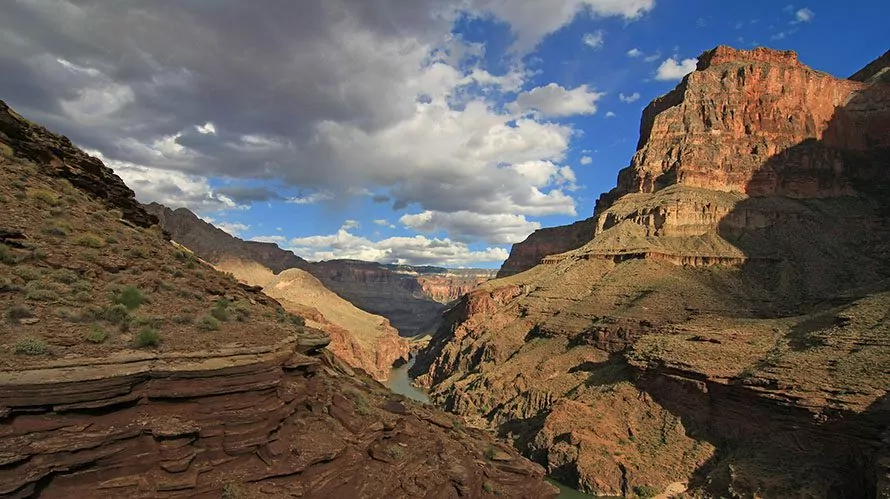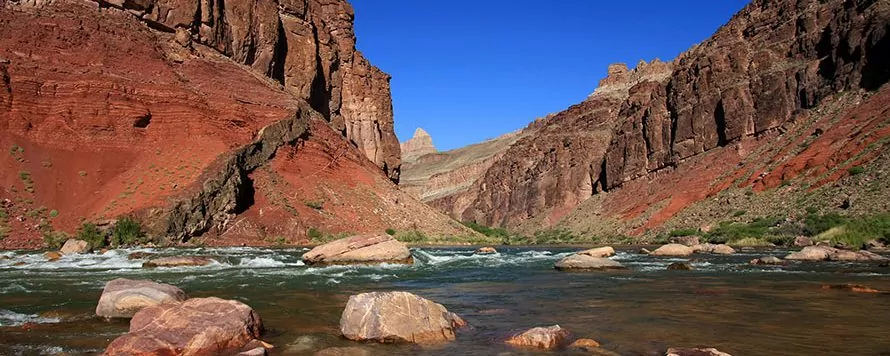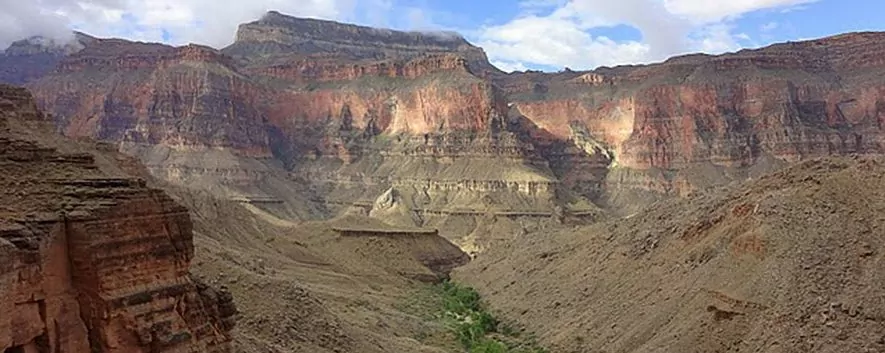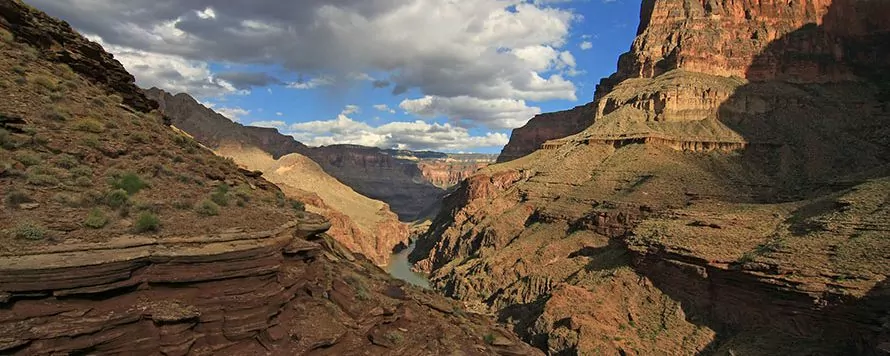
Thunder River Trail
General Description
This trail to Thunder River and Deer Creek is one of the best ways a hiker can truly experience the magic and grandiosity of the Grand Canyon. It is the most adventurous trail on the North Rim, and possibly in the entire Grand Canyon. Hikers will be rewarded with incredible and expansive views of the canyon, roaring waterfalls, mushroom rocks of the Esplanade, experiencing the Colorado River up close and personal, and enormous rockslides that changed the course of the river. Thunder River trail is perfect for multi-day backpacking trips, as the scenery gets better and better the further you go. If you are looking for adventure and want to be blown away by the beauty of the Grand Canyon, this is the trail for you.
Explore Grand Canyon with Expert Guides
Getting to the Thunder River Trailhead
There are two options for trailheads to access Thunder River. The first is from Indian Hollow, and starts directly down the Thunder River Trail, this section was originally designed for stock animals so it is more gradual in grade. Another option is to start on the Bill Hall Trail at Monument Point, this trail is steep and rougher than the trail from Indian Hollow, but it off shaves 2.5 miles, so many hikers opt for this route.
Regardless of which trailhead you decide to start at, you will get on Forest Road 22, which can be accessed a couple miles north of the North Rim entrance station on Highway 67, or a couple miles east of Fredonia on Highway 89A. From FSR 22, you will look for the junction of FSR 425. To get to the Indian Hollow trailhead, you will take FSR 425 to FSR 232. And for the Monument Point trailhead, you will take FSR 425 to FSR 292 then to FSR 292A. You can purchase a North Kaibab National Forest road map here.
History of the Thunder River Trail
Deer Creek has a long history, dating back to 1872, when photographer E.O. Beaman, a crew member on John Wesley Powell’s river expedition, broke away from the group to explore on his own. He was visiting a mining camp when they discovered a waterfall that fell 300 feet into the river, what is now known as Deer Creek Falls. While exploring this area, they also found Deer Creek Narrows and Deer Creek Valley. Thunder Creek and Tapeats Creek had not been discovered, as the miners accessed Deer Creek from Kanab Creek.
In 1880, US Geological Survey geologist Clarence Dutton organized a group and forged a path to Deer Creek east of Kanab Creek, this became the forerunner for the Thunder Creek Trail. The trail was later abandoned after mining ended, and it wasn’t until 1965 that the trail was found and preserved to the trail it is today. For the entire history on Thunder River Trail, click here.

Best Day Hike on the Thunder River Trail
Thunder River Trail is best done as a backpacking trail, as the scenery gets better and better the further down you go. Also, the journey out to the trailhead is pretty adventurous for just a day hike. But, if you happen to be out on these Forest Service roads and only have a day to spend, below is the primary option for day hiking the Thunder River Trail:
| Destination | Miles | Elev | Difficulty | Style | |
| Esplanade Overlook | 11 mi | 2881 ft | Strenuous | Out and Back |
1. Esplanade Overlook
This long day hike is perfect for hikers who want to experience one of the most beautiful, serene and geologically unique areas of the Grand Canyon. It is best to begin at the Bill Hall Trailhead at Monument Point. The trail is a quick and steep descent almost right off the bat. Looking south you will be able to spot the Esplanade and Bridgers Knoll, as well as glimpses of Tapeats Creek to the southwest and Deer Creek to the west. Take plenty of breaks along the way, because there is scarce shade, and if done in the summer, it will be very, very hot. Also, take time on these breaks to appreciate the nature surrounding you. The trail keeps descending rapidly on a series of switchback.
Once reaching Surprise Valley, the trail levels out and is much easier hiking. After approximately 5.3 miles, you will reach the Esplanade, with expanses of slickrock, mushroom rocks, hoodoos and canyons. This area also provides expansive views of the rest of the Grand Canyon. Camping is permitted at the Esplanade if you wish to spend the night. If doing this as a day hike, this is the best place to turn around. Simply go up the way you came down.
Maximize Your Visit to Grand Canyon on a Day Hiking Tour
Guided day hike tours and multi-day packages allow visitors the opportunity to make the most of their time in Grand Canyon National Park and to do it hassle-free. Guided tours include gear (backpack, trekking poles, crampons in winter), meals, accommodations on multi-day tours, local transportation, and a professional Grand Canyon hiking guide. Through their knowledge, stories, and personal passion, guides can bring a place to life in a way that’s much more difficult to do on your own. Read more about Grand Canyon Hiking Tours.
Award Winning USA Hiking Vacations

3 Thunder River Backpacking Trips
Spending a night below the rim on a backpacking trip at Deer Creek or Tapeats Creek should be every backpackers dream. This is the best trail for backpacking in the entire Grand Canyon, and getting to spend multiple days soaking in the magic of the canyon is an experience you will never forget. Listed below are the best backpacking locations along the Thunder River trail.
| Route | Miles | Difficulty | Campgrounds | |
| Tapeats Creek | 22.8 mi | Strenuous | Use Area AY9 Use Area AW8 |
|
| Deer Creek | 19 mi | Strenuous | Use Area AY9 Use Area AX7 |
|
| Tapeats Creek/ Deer Creek Loop | 21.5 mi | Strenuous | Use Area AY9 Use Area AW8 Use Area AX7 |
1. Tapeats Creek (3 days)
Begin at either the Indian Hollow trailhead, or skip the first 2.5 miles and begin at the steeper Bill Hall trail at Monument Point. Each with take you to Thunder River trail. After the junction of the Bill Hall and Thunder River trails, hike 2 more miles to the Esplanade. Here, you can make camp for the night, sleeping beneath the stars, and amongst the mushroom-shaped boulders.
The next morning, you will make your way to the Redwall and at this point you can look down into the guts of what’s yet to come. Descend to Surprise Valley and follow the cairns for Bonita Creek– which has dried up. It is infamously hot in Surprise Canyon, so try to hike this in the early morning. Look for a large cairn that marks a fork in the trail, take the trail east to Thunder River and Tapeats Creek. This will lead you to Thunder River, where you can swim, filter water, etc. When ready to leave Thunder River, the trail will weave along Tapeats Creek to a designated campsite at the Colorado River. The third morning, wake early, and begin your uphill hike back to the trailhead. Camp at either Surprise Valley or back at the Esplanade, if you need one more night in the canyon.
2. Deer Creek (3 days)
Again, begin at either trailhead; both will take you to the Thunder River trail. It is 4.5 steeply descended miles to the Esplanade, which is a great spot to camp the first night. Wake early the second morning, as you will be hiking through the infamously hot Surprise Valley. Be alert for a large cairn that marks the junction for the Deer Creek trail. The trail to Deer Creek is rocky, loose and somewhat exposed as you hike around to the arm of the creek. Deer Spring provides a lovely break and you can rejoice that you are only 20 minutes from camp.
Leave your pack at camp, and head downstream, through “The Patio” to the Narrows. Carved through the tough Tapeats Sandstone, the Narrows are truly mesmerizing, and lead to the Colorado River and the most impressive waterfall in the canyon. Spend as much time in this enchanting place as you can before heading back to camp for the night. The last morning, wake early and try to beat the heat as you make you way back up to the trailhead.
3. Tapeats Creek/ Deer Creek Loop (4 days)
To truly experience it all on the Thunder River trail, you can combine Tapeats Creek and Deer Creek. Read the above description for how to get to Tapeats Creek. On the third morning, follow the path that traverses the Colorado River north to Deer Creek. The trail goes up and down, from beach to cliff, and after 3 strenuous miles, you will reach Deer Creek. Let yourself be engulfed in the majesty and wonder of the creek, the narrows and the waterfall here. Camp at the designated campsite under the Cottonwood trees. On the fourth morning, wake early, and start your way back to the junction at Surprise Valley where you will take the Thunder River trail back to the trailhead.
Join a Guided Grand Canyon Backpacking Trip
Joining a Grand Canyon backpacking tour is a worry-free, adventurous way to experience Grand Canyon. With your gear, meals, local transportation, permits, and fees taken care of for you, you can travel light and focus 100% on enjoying the hiking experience, while the guide company takes care of everything else. Also, by going with local experts you’ll enjoy a greater level of safety and gain a much better understanding of the history and ecology of this remarkable region. Read more about a guided Grand Canyon backpacking trips.
All-inclusive Grand Canyon Backpacking Adventures

When to Hike and Seasonal Considerations
The North Rim is closed from October 15th to May 15th, so you won’t be able to access FSR 22 from Highway 67. Highway 89A to FSR 22 is open year-round however. Make sure you check Grand Canyon weather before starting on any hike. Also, be aware of monsoon storms in the summer months, and know what to do if lightning strikes.
Necessary Permits
Day Hike Permits
Permits are not required for day hiking in Grand Canyon National Park.
Backpacking Permits
Backcountry permits are required for Deer Creek, Tapeats Creek and other campsites along Thunder River. The number of designated sites in each area is limited, so advanced planning is recommended. For more information on Grand Canyon’s permit system, click here.
Suggested Packing List
Day Hike Packing List
- 3-6 liters of water (more in summer)
- Salty, calorie-rich snacks
- lunch
- backpack
- trekking poles
- crampons (in winter)
- wide-brimmed hat
- sunscreen, sunglasses
- non-cotton t-shirt (winter)
- rain jacket
- warm non-cotton layer
- 1st-aid kit
Backpacking Packing List
- all items listed for day hikes PLUS
- multi-day backpack
- 3-season tent
- sleeping bag
- sleeping pad
- water filter
- backpacking stove and fuel
- backpacking meals
- 3 pairs wool socks
- extra t-shirts
Please Respect Our National Parks – Leave No Trace
We strongly recommend abiding by all Leave No Trace ethics guidelines and practices so that our national parks and public lands are preserved for the enjoyment of future generations and for the people and animals who call these places home. Simple things like packing out your trash, obeying national park rules, and respecting the peace and quiet of our national park trails is a great start. If you’re going on a backpacking trip, you can read about more about the 7 Leave No Trace Principles.




